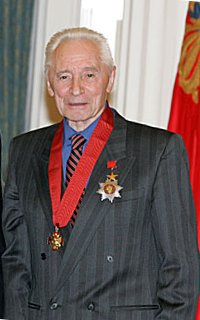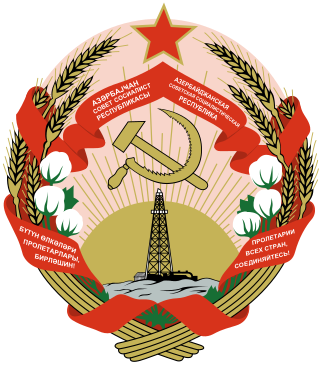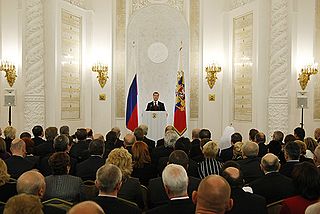
The Republics of the Union of Soviet Socialist Republics or the Union Republics were national-based administrative units of the Union of Soviet Socialist Republics (USSR). The Soviet Union was formed in 1922 by a treaty between the Soviet republics of Byelorussia, Russian Federation, Transcaucasian Federation, and Ukraine, by which they became its constituent republics of the Union of Soviet Socialist Republics.

An Autonomous Soviet Socialist Republic was a type of administrative unit in the Soviet Union (USSR), created for certain ethnic groups to be the titular nations of. The ASSRs had a status lower than the constituent union republics of the USSR, but higher than the autonomous oblasts and the autonomous okrugs.

Yury Nikolayevich Grigorovich is a Soviet and Russian dancer and choreographer who dominated the Russian ballet for 30 years.

Igor Aleksandrovich Moiseyev was a Soviet and Russian ballet master, dancer, choreographer and pedagogue. Moiseyev was widely acclaimed as the greatest 20th-century choreographer of character dance, a dance style similar to folk dance but with more professionalism and theatrics.

People's Artist of the USSR, also sometimes translated as National Artist of the USSR, was an honorary title granted to artists of the Soviet Union. The term is confusingly used to translate two Russian language titles: Народный артист СССР, awarded in performing arts and Народный художник СССР, granted in some visual arts.

The Mari Autonomous Soviet Socialist Republic was an autonomous republic of the Russian SFSR, succeeding the Mari Autonomous Oblast. When the Soviet Union disintegrated, the Mari ASSR became the Mari El Republic, a federal subject of the Russian Federation.

The transfer of the Crimean oblast in the Soviet Union in 1954 was an administrative action of the Presidium of the Supreme Soviet that transferred the government of Crimea from the Russian SFSR to the Ukrainian SSR.

Irina Konstantinovna Arkhipova was a Soviet and Russian mezzo-soprano, and later contralto, opera singer. She sang leading roles first in Russia at the Sverdlovsk Opera and the Bolshoi Theatre, and then throughout Europe and in the United States. People's Artist of the USSR (1966) and Hero of Socialist Labour (1984).

The national emblem of the Azerbaijan Soviet Socialist Republic was adopted in 1937 by the government of the Azerbaijan Soviet Socialist Republic. The style is based on the emblem of the Soviet Union.

The coat of arms of the Kirghiz Soviet Socialist Republic was adopted on March 23, 1937, by the government of the Kirghiz Soviet Socialist Republic. The coat of arms is based on the coat of arms of the Soviet Union. It shows symbols of agriculture on a backdrop of the Ala-Too mountain ranges, surrounded by a frame of folk art of the Kyrgyz people. The red star was added in 1948. The rising sun stands for the future of the Kyrgyz nation, the star as well as the hammer and sickle for the victory of communism and the "worldwide socialist community of states".

The annual Presidential Address to the Federal Assembly is a speech given by the Russian President to outline the state and condition in which Russia is in. It is given in front of a joint meeting of the two houses of the Russian Parliament: the State Duma and Federation Council. Article 84 of the current Constitution of Russia enacted in 1993 says "The President of the Russian Federation shall: address the Federal Assembly with annual messages on the situation in the country, on the guidelines of the internal and foreign policy of the State". First Russian President Boris Yeltsin delivered the first Address to the Federal Assembly on 24 February 1994. The date of the presidential address is not fixed.

The Russian Soviet Federative Socialist Republic, previously known as the Russian Soviet Republic and the Russian Socialist Federative Soviet Republic, as well as being unofficially referred to as Soviet Russia, the Russian Federation, or simply Russia, was an independent federal socialist state from 1917 to 1922, and afterwards the largest and most populous Soviet socialist republic of the Soviet Union (USSR) from 1922 to 1991, until becoming a sovereign part of the Soviet Union with priority of Russian laws over Union-level legislation in 1990 and 1991, the last two years of the existence of the USSR. The Russian SFSR was composed of sixteen smaller constituent units of autonomous republics, five autonomous oblasts, ten autonomous okrugs, six krais and forty oblasts. Russians formed the largest ethnic group. The capital of the Russian SFSR and the USSR as a whole was Moscow and the other major urban centers included Leningrad, Stalingrad, Novosibirsk, Sverdlovsk, Gorky and Kuybyshev. It was the first socialist state in the world.

Gleb Alexandrovich Savinov was a Soviet, Russian painter and art teacher, Honored Artist of Russian Federation, who lived and worked in Leningrad. He was regarded as one of the leading representatives of the Leningrad school of painting, most famous for his genre and portrait painting.
Boris Mikhailovich Lavrenko was a Russian Soviet realist painter, People's Artist of the Russian Federation, professor of the Leningrad Institute of Painting, Sculpture and Architecture named after Ilya Repin, who lived and worked in Saint Petersburg, regarded as one of the major representatives of the Leningrad school of painting.
Nakhchivan, also transliterated as Nakhichevan may refer to:
Ruslan Izrailovich Mamilov was the first Ingush sculptor. In 1990, he was awarded the title of the "Honored Artist of the Chechen-Ingush ASSR". He was considered one of the most talented Ingush artists of his time.

The Declaration and Treaty on the Formation of the Union of Soviet Socialist Republics officially created the Union of Soviet Socialist Republics (USSR), commonly known as the Soviet Union. It de jure legalised a political union of several Soviet republics that had existed since 1919 and created a new federal government whose key functions were centralised in Moscow. Its legislative branch consisted of the Congress of Soviets of the Soviet Union and the Central Executive Committee of the Soviet Union (TsIK), while the Council of People's Commissars composed the executive.

The emblem of the Russian Soviet Federative Socialist Republic (RSFSR) was adopted on 10 July 1918 by the government of the Russian Soviet Federative Socialist Republic, and modified several times afterwards. It shows wheat as the symbol of agriculture, a rising sun for the future of the Russian nation, the red star as well as the hammer and sickle for the victory of Communism and the "world-wide socialist community of states".

The 1927 Constitution of the Azerbaijan Socialist Soviet Republic was adopted by the Central Executive Committee of the Azerbaijan SSR at the 5th All-Azerbaijani Congress of Soviets on March 26, 1927.

Honored Artist of the RSFSR was an honorary title granted to Soviet artists, including theatre and film directors, choreographers, music performers, and orchestra conductors, who had outstanding achievements in the arts, and who lived in the Russian Soviet Federative Socialist Republic (RSFSR).

















